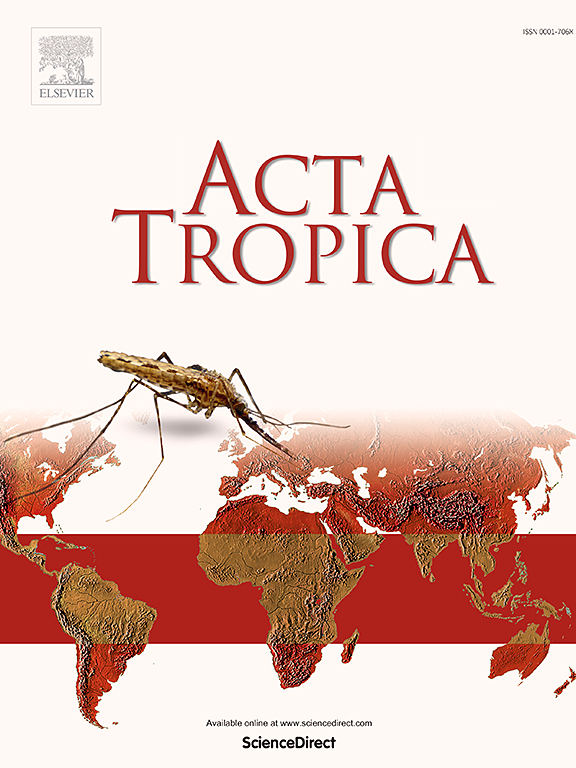Vector-borne pathogens in dogs and in Rhipicephalus sanguineus sensu stricto ticks in Morocco
IF 2.1
3区 医学
Q2 PARASITOLOGY
引用次数: 0
Abstract
Canine vector-borne diseases (CVBDs) are of major concern in veterinary medicine worldwide. Amongst the arthropods transmitting CVBD-causing pathogens, the brown dog tick (Rhipicephalus sanguineus sensu lato) is an important vector of agents, such as Babesia vogeli, Cercopithifilaria spp., Ehrlichia canis, Hepatozoon canis, and Anaplasma platys. While data on CVBDs transmitted by Rh. sanguineus s.l. are limited in Morocco, Leishmania spp., transmitted by phlebotomine sand flies, are known to be endemic in several regions of the country. In this study, we investigated the occurrence of tick-borne pathogens (TBPs) (i.e., Anaplasma spp., Babesia spp., Ehrlichia spp., Hepatozoon spp., Rickettsia spp.), Leishmania spp. and filarioids in shelter dogs and their ticks in central Morocco. Blood samples were collected from 144 dogs, and 5,363 ticks were removed from 314 dogs of the same population. DNA samples extracted from blood and from 276 ticks (divided into 55 pools) were screened for selected pathogens by PCR and DNA sequencing. Ticks were morphologically identified as Rh. sanguineus s.l., and molecular analysis of 10 representative specimens confirmed them as Rh. sanguineus s.s. Out of 144 dogs tested, 78 (54.1 %) scored positive for at least one pathogen, with 15 (10.4 %) being co-infected. H. canis was the most prevalent pathogen (38.2 %, 55/144), followed by L. infantum (15.3 %; 22/144), A. platys (5.6 %; 8/144), B. vogeli and E. canis (2.8 %; 4/144). Tick DNA pools scored positive for H. canis (36.4 %; n = 20/55). All dogs tested negative for filarioids and Rickettsia spp. Data herein reported demonstrate a high overall prevalence of CVBD-causing pathogens in dogs from central Morocco, with the unprecedented report of H. canis in dogs and ticks in this country.

犬病媒传染病(CVBD)是全世界兽医学关注的主要问题。在传播导致 CVBD 的病原体的节肢动物中,褐狗蜱(Rhipicephalus sanguineus sensu lato)是一种重要的病原体传播媒介,例如巴贝西亚蜱(Babesia vogeli)、栉水母蜱(Cercopithifilaria spp.)、犬艾氏菌(Ehrlichia canis)、犬肝吸虫(Hepatozoon canis)和板疽(Anaplasma platys)。在摩洛哥,由沙蝇传播的 CVBDs 数据有限,而由血吸虫沙蝇传播的利什曼原虫则在该国多个地区流行。在这项研究中,我们调查了摩洛哥中部收容犬及其蜱虫中蜱传病原体(TBPs)(即阿那普拉斯菌属、巴贝斯菌属、埃利希菌属、肝包虫属、立克次体属)、利什曼原虫和丝虫的发生情况。研究人员从 144 只狗身上采集了血液样本,并从同一群体的 314 只狗身上清除了 5363 只蜱虫。通过聚合酶链式反应和 DNA 测序,对从血液和 276 只蜱(分为 55 组)中提取的 DNA 样本进行了选定病原体的筛查。在接受检测的 144 只狗中,78 只(54.1%)至少对一种病原体呈阳性反应,其中 15 只(10.4%)同时受到感染。犬蜱是最常见的病原体(38.2%,55/144),其次是利什曼原虫属(15.3%;22/144)、A. platys(5.6%;8/144)、B. vogeli 和 E. canis(2.8%;4/144)。蜱虫 DNA 池对犬蜱呈阳性(36.4%;n = 20/55)。本文报告的数据表明,摩洛哥中部地区的狗体内导致 CVBD 的病原体总体流行率很高,狗和蜱虫中的犬白喉杆菌的报告也是史无前例的。
本文章由计算机程序翻译,如有差异,请以英文原文为准。
求助全文
约1分钟内获得全文
求助全文
来源期刊

Acta tropica
医学-寄生虫学
CiteScore
5.40
自引率
11.10%
发文量
383
审稿时长
37 days
期刊介绍:
Acta Tropica, is an international journal on infectious diseases that covers public health sciences and biomedical research with particular emphasis on topics relevant to human and animal health in the tropics and the subtropics.
 求助内容:
求助内容: 应助结果提醒方式:
应助结果提醒方式:


